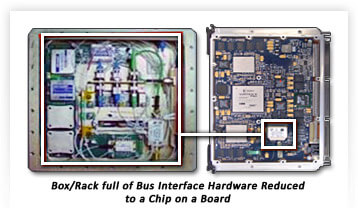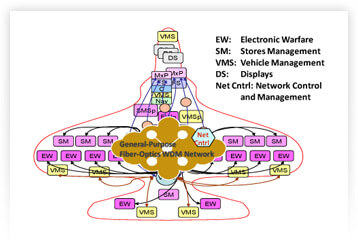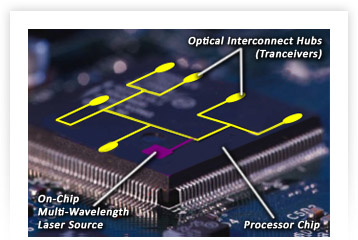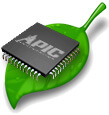Next Generation Silicon Photonics
“The heat created by so many transistors stuffed onto a tiny sliver of silicon has pushed the thermal conductivity of copper interconnects to their limit.” – Adam Penenberg, Slate Magazine
Military electronics have gotten smaller, faster, and more efficient. But miniaturizatio

Highly Integrated Photonics (HIP) is the merging of photonic integrated circuits with electronic integrated circuit components to enable extremely small and efficient interface and control for multiple channels of wavelength division multiplex (WDM) data or signals over fiber.
n in electronics has hit its physical limit of heat dissipation in the copper wiring and interconnects upon which it is based. Additionally, today’s military platforms contain multiple special purpose networks requiring continuing upgrades, cable replacements, unwanted weight additions, increased power consumption. These wire data links are costly to install and maintain. The answer is Photonics- using photons instead of electrons, and optical fiber instead of copper cabling, for information processing and transmission. However until now, introducing photonics into military networks meant replacing wires with fiber one for one, necessitating addition of expensive and bulky converters. The solution is to integrate photonic and electronic components at the chip level, and enable a single fiber to carry all the information for the entire network, digital and analog. That is what APIC has done.
Let There Be Light
“When compared with conventional electronics, silicon photonics provides 90% of its efficiency with one-third the power consumption at one-tenth of the cost.” – marketsandmarkets.com
“Silicon photonics is the only technology likely to be capable of removing bandwidth bottlenecks, thereby extending system performance beyond the end of Moore’s law.” – A.F.J. Levi

Overall vision of our DARPA/Navy-funded HIP program. A totally networked approach – not just a one-for-one cable swap-out
APIC harnesses common silicon and well-known CMOS processes to integrate optical and electronic components on a single substrate. This combines the familiarity and economics of conventional electronic manufacturing with the massive benefits of photonics, including reduced power consumption, diminished size and weight, immunity to electromagnetic interference (EMI) and electromagnetic pulse (EMP); and vastly increased bandwidth. We call it Highly Integrated Photonics.
The same problem that plagues miniaturization- heat dissipation- also limits current multi-core processors, along with the communication time latency inherent to electronic multi-cores. APIC’s

US Government-funded, fully-laser-integrated processor
Fully Laser Integrated Processor (FLIP) program funded by the US Government will deliver a 1024 core, non-blocking, optically interconnected processor that will solve the latency problem of complex multicores while reducing the power required to a fraction of today’s.

